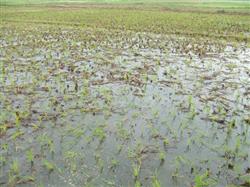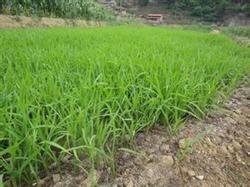Occurrence and Control of withered Heart Disease in Rice

In the process of rice growth, it is often caused by diseases or insect pests. Correctly judging the causes of "withered heart" of rice and taking targeted measures to control them in time are effective measures to ensure high and stable yield of rice. 1. Simple diagnosis of rice "withered heart" 1. "withered heart" caused by insect pests. Chilo suppressalis, Chilo suppressalis and mole cricket can cause "withered heart". The main differences are as follows: the symptoms of Chilo suppressalis damage are as follows: the symptoms of Chilo suppressalis damage are large wormhole, many insect feces, and feces are generally excreted between rice leaf sheath and stem. The stem, leaf sheath and leaves of the affected rice turned yellow. The harm is more serious at the edge of the rice field and lighter in the middle of the field. The damage of Chilo suppressalis showed that after hatching, the young borer first gathered on the inside of the rice leaf sheath to feed, and water-stained macula appeared outside the damaged leaf sheath, and then gradually yellowed and withered. The young borer is slightly larger and then enters the rice stem, causing the tip of the rice flag leaf to turn yellow, and when the heart leaf is serious, the heart leaf dies. There are wormholes on the stems of the decayed rice, and there are less insect droppings outside the holes and more in the holes. The harm of Chilo suppressalis is that the young borer first eats rice heart leaves, resulting in water loss of heart leaves such as onion tube-shaped, bluish white, commonly known as "false withered heart". Pull out the curled heart leaves, and you can see that the section is neat. If the borer continues to do harm, biting off the heart leaf and destroying the growing point, the heart leaf will die completely and become a "really withered heart". The boiled rice stem worm hole is small, there is no insect feces outside the hole, and there are white fine-grained insect feces in the hole. Mole blight harms rice and often bites off some or all of the rice clumps from the base, causing rice heart leaves to turn yellow and wither. The damaged rice is easy to pull up the whole plant, and there are no wormholes and insect dung on the rice stem. This kind of heart withering usually occurs only when rice fields are exposed to the sun or because of long-term drought and there is no water in rice fields. 2. "withered heart" caused by disease. Both rice virus disease and bacterial leaf blight can cause rice "withered heart". The difference between them is that the symptom of "withered heart" caused by virus disease is similar to that caused by Chilo suppressalis, but there are no wormholes and feces on rice stems, and the heart leaves are not easy to pull up. Leaves are sandwiched in a piece of glass to squeeze aseptic pus. The "withered heart" caused by bacterial blight mainly occurred in the tillering stage of rice. After the disease, the diseased plant heart leaf or 1-2 leaves below the heart leaf lost water, curled, withered, necrotic, then other leaves also gradually curled, withered, and finally the whole plant leaf withered. Take a small piece of fresh diseased leaf and squeeze it in a piece of glass and look at the light. You can see that there is pus flowing out of the yellow bacteria at the vein mouth of the leaf. Second, the "withered heart" of rice can be controlled by spraying Regent, killing borer, insect setback and other symptomatic insecticides. The withered heart caused by the harm of mole cricket can be killed by bait such as wheat bran mixed with trichlorfon when rice falls into the water and basks in the field. For the withered heart caused by virus disease, the rice seeds should be soaked with strong chlorine before sowing, and the control of poisonous insects such as rice planthopper and leafhopper should be done well. For the withered heart caused by bacterial blight, in addition to disinfecting rice seeds, in the early stage of bacterial blight, symptomatic agents such as Shibaoling and Yekuning should be sprayed to control the disease.
- Prev

Cultivation techniques of No-tillage and dry Direct seeding of Rice
(1) Paddy fields that were previously used as rice without ploughing were selected for no-tillage, dry and direct seeding cultivation. Fields with many malignant weeds and heavy stickiness are not suitable for no-tillage cultivation. (2) 4-6 days before weed treatment and sowing, choose sunny or cloudy days with temperatures above 15 degrees and use 10% glyphosate 2 kg per mu.
- Next

Field Management of dry raising Rice seedlings and transplanting in the Field
1. Fine field preparation, so that the field is flat and muddy, and an inch of water does not expose mud. 2. Fertilization principle: heavy application of base fertilizer and skillful application of spike and grain fertilizer. The amount of farm manure per mu is not less than 1500 kg. When raking the field, 70% of phosphorus, potash and nitrogen fertilizer are applied at one time, 20% of nitrogen fertilizer is used as tiller fertilizer, and 10% is used as panicle fertilizer (5 ml 10 days before heading). ...
Related
- The first cup of black tea in spring, the flavor and history of tea gardens in Kenya, Africa
- The computer can not only choose potatoes, but also grow tea rice. AI will grow winter oolong tea champion.
- It is not only the inflated tea bitten by insects, but also engraved with the four seasons tea in Beipu.
- The Oriental Beauty Tea Festival in Zhuxian County takes the stage at the weekend to experience the plus-size feast of oil tea.
- & quot; Oriental Beauty Tea & Exploration of Emei in Hsinchu, the hometown of quot;
- The new variety of strawberry "Tainong 1" dessert is the first choice with mellow aroma. Crimson gorgeous
- History of Tea in Taiwan: from Wild Inner Mountain to Export Tea Garden
- Two types of Taiwan Oriental Beauty Black Tea won the British three-Star Award for Childhood Tea Xiang Zhang Jiaqi changed from pilot to champion tea maker.
- Banana species and varieties: the planting history of Taiwan Xianren banana and dwarf banana is long, is banana disease resistant?
- Coffee planting Technology: Qianjie Coffee from Seedling to harvesting

